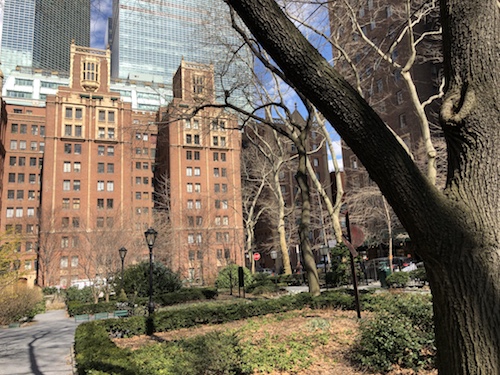Tudor City, the housing complex on Manhattan's East Side near the United Nations, isn't just a quiet, rather insular neighborhood of co-ops, 1920s brick architecture, and landmarked facades.

Tudor City was marketed when it opened in the 1920s as "An Ideal Residential Development Within a Few Minutes' Walk of the Business Center of the Greatest City in the World." It's been on the National Register of Historic Places since 1986, and an official New York City Historic District since 1988. I was aware of Tudor City but had never visited, and I certainly never knew that it includes the Tudor City Greens, two adjoining little parks along Tudor City Place, privately owned, open to the public, and run by a nonprofit.



Crocuses (I think that's what these are) were blooming on a sunny day in March.

And despite the chill, a few sunny souls were enjoying a sit.


The developers of Tudor City couldn't take advantage of the nearby East River views because the intervening land, now the UN, was "the site of stinking slaughterhouses and meatpacking facilities, and a gas works," according to Brick Underground. Instead the apartment buildings were designed to look out over the burgeoning city neighborhoods to the west.
Today, for river views, this is the best you can do from the street:

Fred F. French, the founder of the company that developed Tudor City, was, according to The Real Deal, "[b]orn into poverty" and "had to go to work as a young boy, selling newspapers and doing odd jobs to help support his family. Yet he also managed to stay in school, and eventually study engineering at Columbia University." Just like today's most famous real estate mogul, no? How times have changed. When French died in 1936, his estate was valued at "less than $10,000 in personal property and no real estate."
You may know about the popular Showtime TV series The Tudors. You probably don't know that early music choral group New York Polyphony has an album called Tudor City, which "explores the music of Tudor England" through "chant, polyphony and renaissance harmonies." (Readers of my reviews at Blogcritics know that I frequently cover this kind of music.) It seems old Tudors never really die, whether in the Old World or the New.